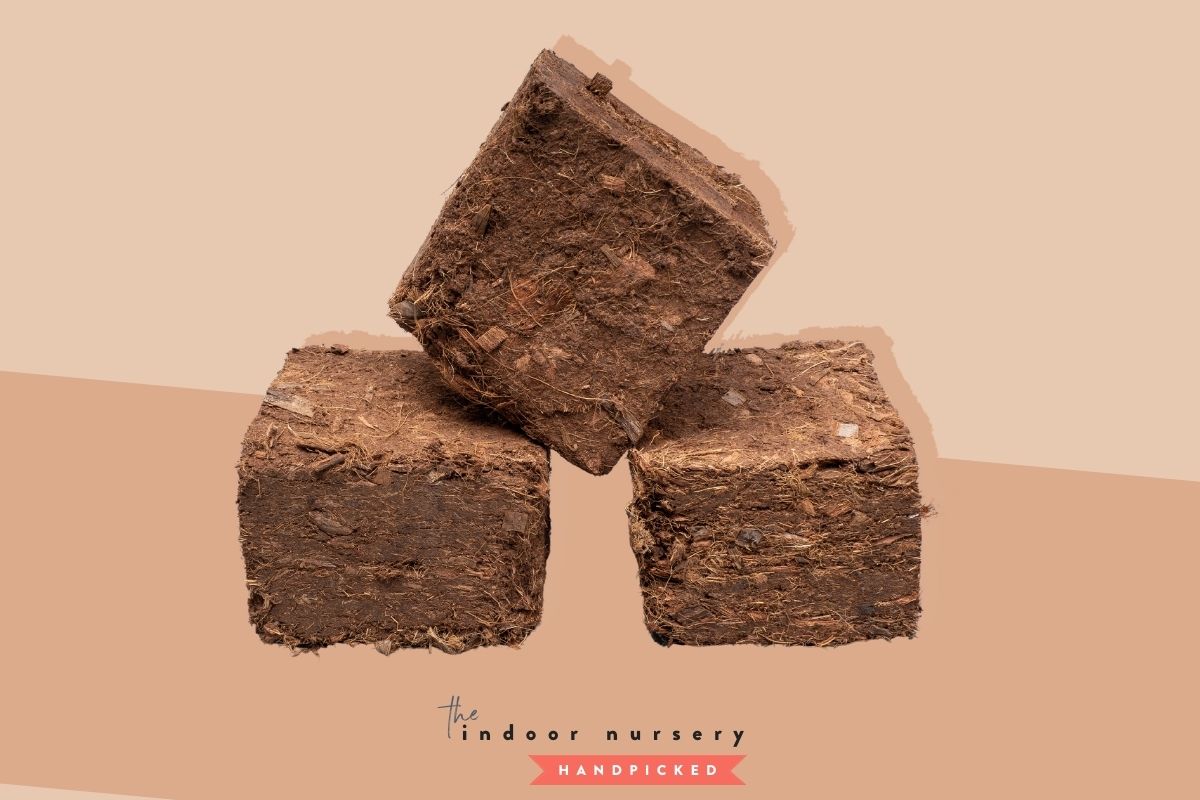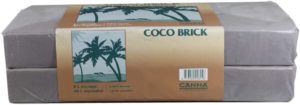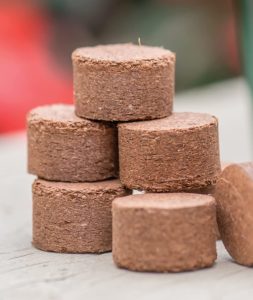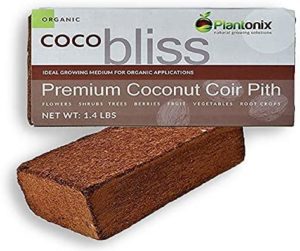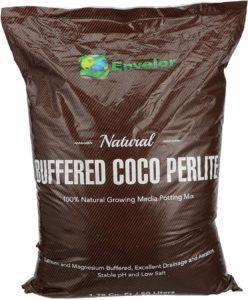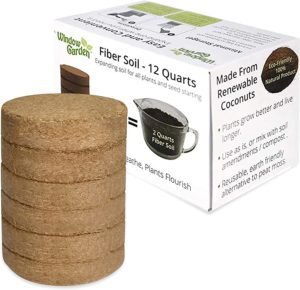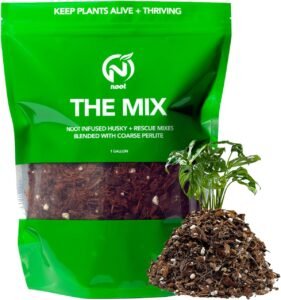🧪 Our review process
Our testing team independently researches, tests, and recommends the best products to help keep your houseplants absolutely thriving. Learn more about our testing and review process here.
If you struggle with pest infestations in your current potting soil, re-potting in tight spaces, or overwatering your houseplants, it might be time to switch your growing medium from traditional soil to coconut coir.
But how do you know you’re getting the best coco coir out there? Coir comes in many forms, which are processed with different methods and uses in mind, so this guide will help you figure out what you need.
Coir a renewable resource (unlike peat moss) made from coconut husks that makes an excellent growing medium on its own or as an addition to soil mix, thanks to its miraculous capacity to both hold and release water.
Say hello to your new personal plant-watering assistant, coconut coir – and find the best for your gardening ambitions:
The best coconut coir
1. Best overall coconut coir: CANNA Coco Brick
Key specs: single package contains two separately-wrapped 4 L dry bricks | 40 L expanded soil | RHP certified and super high quality
The CANNA Coco Brick is the holy grail of coir products. This coconut coir brick has been specifically developed by CANNA, a Dutch brand globally known for its coir products, to ship more easily than its expanded version.
The fiber in this brick expands to a fine, coco-peat consistency, perfect on its own or as an addition to your favorite potting mix.
We especially like that the packaging transforms into a mixing vessel, and that each brick (it comes with two) can be broken into two chunks to make 10 Liters of expanded soil, thanks to its pre-perforated structure.
Pros
- Super high-quality coco coir certified by RHP, non-steam sterilized for ideal water retention, chemical stability, structure and stability
- Each coco coir brick is pre-perforated for easy measuring and can be blended in its package
- Smart perforated design (each brick is stamped with a hole) increases the surface area of the brick, quickening water absorption and making rehydration a breeze
Cons
- Besides one teensy inconvenience – there is no consistency description of this product – there’s nothing to say here, folks 😉
2. Best coco coir for starting seeds: Burpee XL Super Growing Pellet
Key specs: 32 pellets included in bag | expand to 10 1/8 cubic inches of soil | low mess for quick planting
These coco coir pellets hold more water than peat moss seed starting plugs, and are just as easy to portion off for your next Spring grow. Formulated with a low salt content mix of super-fine coir ideal for starting seedlings, these pellets will give your sprouts everything they need to get a good start in the world 🌱
These little pellets hold enough water to feed your seedlings consistently in their early days, and increase drainage when roots begin to grow.
Pros
- Super fine, pre-washed and buffered coconut coir pellets contribute to fast germination and healthy, strong root growth
- 100% satisfaction guarantee from Burpee – the company will replace any pellets that don’t fully expand
- Easy to portion off into seed-starting trays, and even easier to store for next season
Cons
- Some customers find the discs to be overly-compressed and difficult to rehydrate; we recommend giving them a good hour-long hot water bath
- They’re pretty pricey. For only a few dollars more, you can buy a seed starting kit from Burpee including 2 x the pellets, trays and cover
3. Best bulk coconut coir: Plantonix Coco Bliss Coir Brick
Key specs: comes in 5, 20 or 50 1.4 pound bricks | 20 bricks expand to roughly 160 L of soil | OMRI listed
If growing seeds is small potatoes compared to your growing ambitions, you need to buy your coconut coir in bulk 💪🏾We recommend these bricks from Plantonix, which offer all of the advantages of a coco coir soil replacement, PLUS a great bulk discount.
These coconut coir bricks retain water like a dream, boast OMRI listing as good for growing organic food, and are ideally suited for container gardening, composting, or mulching applications.
Order up to 50 of these coco coir bricks to fulfill all of your growing media needs FOR LIFE, and maybe have some leftovers to use as bedding for your human children 😉 (jokes, folks – do not use this for your kids).
Pros
- OMRI listed for organic use makes this an excellent sustainable replacement for peat moss
- Excellent quality control standards in processing means this coconut coir is fresh water rinsed with low EC and pH levels between 5.8-6.8
- Produced without steam-sterilizing or harsh chemical treatment
- Produced by an Oregon-based, family-owned business Order up to 50 coco coir bricks to fulfill all of your growing media needs
Cons
- The manufacturer warns that brick sizes vary, making it difficult to measure this product in compressed form
- Occasionally, buyers report that the blocks come un-wrapped, which may expose the coir to moisture in shipping, but their customer service will help if products are damaged in transport!
4. Best pre-blended coco coir potting mix: Envelor Potting Soil Coco Coir & Perlite Mix
Key specs: 50 L bag of expanded soil | pre-buffered 70% coco coir and 30% perlite blend | ready to use
If you’re new to using coconut coir and are interested in diy hydroponic gardening or just sustainable alternative to traditional soil, this coco coir is a good place to start. It’s pre-hydrated, so it will look and behave more like the potting mixes you’re familiar with right out of the bag.
This coco coir comes pre-buffered (meaning it’s been stabilized to hold a specific pH range and nutrient holding capacity, in this case with magnesium and calcium), and is a blend of fine-grained coco peat and vermiculite. It’s a good starter option, and is more convenient than the blocks and pellets if you don’t mind storing it!
Pros
- This coco coir is well-suited to beginners as it comes in fully-hydrated, familiar form
- Pre-buffered soil with magnesium and calcium is formulated to maintain a steady, neutral pH level around 6.0 and is ready to use right out of the bag
- High water holding capacity and air fill porosity
Cons
- This bag is big and heavy. Adds to shipping costs, and overall cost of the product
- Some buyers report inconsistent coconut coir blends that contain random bits here and there, so be prepared to sort
5. Best coco coir bricks: Window Garden Expanding Organic Fiber Soil Pucks
Key specs: 6 compressed discs | expanded total soil volume is 12 quarts | pre-portioned and easy to store
Coconut coir discs aren’t only for starting seeds: They offer an easy way to portion and store your coconut coir soil, while reducing the mess and guesswork involved in re-hydrating coir that comes as a compressed brick.
These discs are made of coco pith and fine fiber. With a bit of water and fertilizer, your plants will be living the coco life in this easy to use soil replacement.
Pros
- Nicely portioned into six individual discs that expand to roughly 2 quarts of coconut coir medium each, enough for potting 3-4 small plants or 1 large plant
- Easy to store
- Coco-peat blend is well-suited to average houseplants, as well as herbs, seeds, and microgreens
Cons
- You pay for the individual packaging, but for some this is worth it
- No information about where this coconut coir is sourced or how it is produced is included in product information
6. Best coco coir chips: Noot “Husky Mix” Indoor Coconut Husk Potting Mix
Key specs: comes semi-compressed in a .75 gallon bag | hydrates to about 1.5 gallons | chunky blend of coco chips, husks and fibers
This coconut coir is ideal for Aroids (plants from the Arum family) like pothos, ZZ plants, aglaonemas, and monstera that like soil with a bit of umph. It’s a chunky blend of coconut chips, shredded husk and loose fibers, that holds together better than the average orchid mix.
Soak in Noot’s Bio-Organic Plant Food fertilizer and water during re-hydration for a quick, ready-to-use coconut coir soil.
Pros
- Perfect for aerating roots and improving root stability; amazing airflow and hydration in one!
- The chunky blend of chips, husks and fibers allow easy root inspection and stress-free transplanting for root-sensitive potted plants
- Safe to hydrate, de-hydrate, and re-hydrate again
Cons
- Some buyers report that this mix doesn’t expand to the promised volume
- Expensive for the volume and lack of quality certifications
Our recommendations
| # | Preview | Product | Amazon rating | |
|---|---|---|---|---|
| 1 | best overall coconut coir: CANNA Coco Brick | 4.8 out of 5 | view on amazon | |
| 2 | best coco coir for starting seeds: Burpee XL Super Growing Pellets | 4.3 out of 5 | view on amazon | |
| 3 | best bulk coconut coir: Plantonix Coco Bliss Coir Brick | 4.7 out of 5 | view on amazon | |
| 4 | best pre-blended coco coir potting mix: Envelor Potting Soil Coco Coir & Perlite Mix | 4.7 out of 5 | view on amazon | |
| 5 | best coco coir pucks: Window Garden Expanding Organic Fiber Soil Pucks | 4.5 out of 5 | view on amazon | |
| 6 | best coir chips: Noot “Husky Mix” Indoor Coconut Husk Potting Mix | 4.5 out of 5 | view on amazon |
Still unsure which coconut coir is best for your indoor garden?
We get it – there are so many choices! If you’re still unsure which coconut coir best suits your indoor garden, here are a few tips to help you make the best choice. Many plant lovers are hesitant about switching out traditional soil with coco coir products because they behaves so differently from soil and do require some doctoring up.
Here are a few tips for choosing the best coconut coir and using it successfully with your indoor plants.
What is coco coir?
Coconut coir, also known as coco coir or just coir, is a 100% naturally-derived plant fiber from – you guessed it – coconuts! Specifically, the outer layer of coconut husk 👆 Coco coir is used in the gardening world as a growing medium t due to its ability to hold many times its weight in water, sterile properties (bye-bye pests, fungus, and bugs), and versatility.
It is primarily sourced from Asia and Africa, specifically from these countries, according to the non-profit foundation for growing media RHP:
- India
- Sri Lanka
- Ghana
- The Dominican Republic
In the gardening world, coco coir is often the main ingredient in potting soil replacement products marketed as inert growing media, soilless soil, and fiber soil alongside Rockwool and LECA.
Most coir used for growing plants is made of brown coir, the strong coconut husk fiber harvested from ripe coconuts. You may see something called white coir used in non-horticultural fiber products; this is simply the coconut fiber harvested from non-ripe coconuts.
Advantages of coconut coir
Where to begin? Coir has soooo many advantages as a growing medium. This soil replacement:
- Often comes in de-hydrated form. Compressed coconut coir bricks reduce shipping costs, lowering the cost to buy it and making it easier to store in apartments and small spaces
- Provides excellent drainage and aeration as a soil amendment, preventing root rot in many houseplants
- Is a renewable resource, unlike the peat bogs that are destroyed in the harvest of sphagnum peat moss – one the coir’s substitute products
- Is actually a leftover waste product of the coconut industry that used to be thrown away before becoming widely used in garden soil
- Is sterilized after harvest to prevent pathogen and bacteria growth
- Has a relatively neutral pH of 5.5-6.8, which is right in the range of “yes, please” for most houseplants
Disadvantages of coconut coir
There are some downsides to coconut coir, like anything. Here’s what you should be aware of. Coir:
- Can involve heavy chemical treatment in its production process, which is difficult to determine as a buyer since many products do not list the source of the coir
- Doesn’t hold quite as much water as peat moss, and is therefore often mixed with perlite to make a 1:1 replacement
- Doesn’t contain any nutrients, as compost and soil does, so it requires additional fertilizer to feed your plants
Most common types of coconut coir
Coir is suitable for a wide range of gardening uses and plant care needs, indoors and out. The difference between most coconut coir products is in coconut processing, which affects the water retention capacity and structural qualities of the resulting form of coir.
Here are the most common types of coir products you’ll find for indoor gardening:
Coco Coir Pole
Coir poles are a common alternative to moss poles – they give the aerial roots of climbing plants like pothos and philodendron something to hold onto as they climb skyward. Coir poles are typically made of coconut fibers loosely spun around a wooden stake.
Coco Coir Mat
Nope, not the welcome mat variety!) Typically sold in spongy rolls, coir mats are great for starting microgreens and herbs and are also useful for lining hanging pots, indoor containers, and hydroponic trays. They are often a blend of coconut fiber and coco peat, depending on the intended use, so double check before purchasing.
Coco Chips
Coco chips look like chunky playground wood chips, but they’re 100% coconut husk. Coco chips have the same water retention benefits of other forms of coir, but they create more air pockets in the soil. Coco chips are great for orchid and epiphyte soil mixes and are also used as mulch.
Coco Fiber
Coco fiber is a roughly spun, loose fiber that’s not as absorbent as other forms of coir, but creates plenty of aeration in chunky soil mixes.
Coco Peat
Also called coco pith, coco peat is a finely ground form of coir used as a 1:1 replacement for peat moss. It’s one of the most common forms of coir available, so if your product doesn’t list the type of coir, it’s safe to assume you’re buying coco peat. It’s about the texture of coffee grounds used to make drip coffee and is best mixed with other forms of coir for balanced water retention.
Sustainable certifications and what they mean
When it comes to finding high quality products that are good for buyers and the environment, there are a couple of certifications to keep in mind. Note that these certifications both cost manufacturers to maintain, so some smaller businesses selling products that meet these standards may choose to by-pass the certification process.
RHP Certification
RHP certification is a quality mark from a Netherlands-based non-profit organization focused on growing media. This stamp ensures you, as a consumer, are purchasing a clean and pure product, free from pathogenic organisms and harmful weed and pest killers that is what it says it is. It doesn’t ensure that
OMRI Certification
OMRI is an international non-profit that works with the USDA and other North and Central American agricultural agencies to approve input products allowed for use by certified organic farms, producers, and manufacturers (it has programs in Canada and Mexico). It focuses specifically on meeting organic regulations in the US, which actually aren’t the highest standards in the world – but are a good start.
You should see this certification displayed as OMRI Listed® on your coir product (if not, check the website’s registry). If you’re into growing organic produce with your coco coir, the certification will ensure that your fruits, veggies, and herbs are up to USDA standards if you adhere to other organic growing guidelines.
How to use coconut coir
It’s easier than you think! If you’ve used clay pellets / LECA in potting mix, you’ll have a head start on how to use coconut coir to make your plants happy 🌱 😁
One of the great things about coir is that it typically comes in compressed, dry form – meaning no giant, moist bags of soil to store indoors, which so often attract pests, mold, and curious pets. All you need to do is re-hydrate the coir (instructions and ratios are almost always included on the package), and it’s ready to go!
Here are some popular ways to use coir in all of its amazing forms:
- Mix with potting soil for improved aeration and drainage
- Wrap around stakes, trellises and structures to support for vining plants
- Portion in small discs for easy, fast and effective seed-starting
- Layer on top of cold-sensitive plants as mulch in your winter garden
What nutrients to add to coconut coir
This part isn’t optional, plant people! You’ll definitely need the right fertilizer to provide the nutrition your plants need to grow when you choose coir as a growing medium. Remember that coir isn’t fertile, like compost, so you’ll need to supplement your plant’s food with some specific nutrients.
The best nutrients for coco coir should be mixed with fresh water and added to your watering can in the dosage recommended on the product you buy. Look for products labeled as hydroponic nutrients, which will suit the pH level and growing conditions plants need when growing in coir, which is sometimes referred to as semi-hydroponic growing, or “cocoponics” 😂.
Here are the primary nutrients you’ll need to supplement your coir soil mixture with:
- Calcium: a secondary nutrient that helps plants develop healthy cell structures
- Nitrogen (N): a primary nutrient that is found in chlorophyll molecules, enabling plants to convert light to energy efficiently
- Magnesium: a secondary nutrient that activates crucial enzyme systems that build and re-build your plant’s structure
- Phosphorous (P): a primary nutrient found in every living plant cell that works in energy capture and transfer, the breakdown of sugars and starches, and nutrient movement
- Sulfur: a secondary nutrient vital to protein production and chlorophyll formation
- Potassium (K): a primary nutrient that aids in the movement of nutrient-rich fluid in plant tissues
Read our epic breakdown of what nutrients plants need to grow for a thorough review of every single nutrient.
Conclusion
Are you loco for coco coir yet, like us? 😜 All jokes aside, we hope this guide has given you the confidence to use coconut coir as a replacement for peat moss, as a main ingredient in your homemade potting mixes, and as a structural climbing medium for your vining potted plants.
Shop our recommendations
- The Best Hydroponic Tower For Indoor Gardening
- 10 Best Worm Composter Bins For Easy Homemade Compost
- The Best pH Meter For Soil
- The 6 Best Dehumidifiers For Grow Tents
- The Best Complete Indoor Hydroponic Grow System
- 5 Best Grow Light Strips For Indoor Plants
- TESTED: Aerogarden vs Click and Grow Smart Garden
- Our *hands on* MARS HYDRO TSW 2000 review (with photos)
- 7 Best Hygrometers For Indoor Plants
- The Best Coco Coir For Your Plant’s Healthiest Root System Ever
- Tags:
- coco coir

